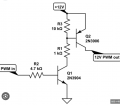Hey Guys,
I have a question around this, the PWM signal is it a 2.5v pwm ?
I am about to repair a heap of strings of these and the main CPU that drives it has blown up, so i would like to rig up a test circuit to do so before replacing the motherboard.
Was just going to use an Arduino with a level shifter on it to change the voltage if required.
Note the level shifter diagram has 12V as i stole it from google i would make this 2.5v if i am reading the data sheet correctly.
Thanks Guys


I have a question around this, the PWM signal is it a 2.5v pwm ?
I am about to repair a heap of strings of these and the main CPU that drives it has blown up, so i would like to rig up a test circuit to do so before replacing the motherboard.
Was just going to use an Arduino with a level shifter on it to change the voltage if required.
Note the level shifter diagram has 12V as i stole it from google i would make this 2.5v if i am reading the data sheet correctly.
Thanks Guys


Last edited by a moderator:





